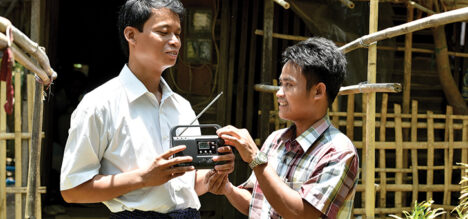Is a Super Volcano Coming?
June 1, 2010
The eruptions from the Eyjafjallajokull volcano in Iceland in April this year could be a warning of even bigger volcanic eruptions to come.
Even though Eyjafjallajokull was nothing particularly powerful, it’s been quite a nuisance, causing havoc in the European skies, grounding 63,000 flights. Each day of the shutdown cost the European travel industry more than $US1 billion.
Eyjafjallajokull has erupted three times in the past 1000 years: 920, 1612 and 1821-23. There are some researchers who are suggesting that April’s eruption could trigger even bigger eruptions in the much larger neighbouring volcano, Katla. In its past three eruptions of Eyjafjallajokull, they warn us, there have been eruptions of Katla within two or three years, sometimes within a few months.
Within Iceland Katla is one of the most studied volcanoes. Its peak is only 45 km from Eyjafjallajokull. According to the experts, Katla’s magma chamber sits high above the earth’s crust. Since Katla’s last eruption in 1918, enough time has passed for a large volume of magma to collect there.
Magma doesn’t just shoot up into the air; it also moves laterally under the earth’s surface. Experts are concerned there may have been a large such flow that might disturb the magma chamber under Katla. As the ice is much thicker over Katla, it’s feared that if it erupts it will create a debris cloud to dwarf the one that hung over Europe from Eyjafjallajokull.
Scientists rank volcanoes according to how explosive they are, using the volcanic explosivity index (VEI), which ranges from zero to eight. The measurement is based on how much material is thrown out of the volcano, how high the eruption goes, and how long it lasts. Like the scale that measures earthquakes, the VEI is logarithmic-which means that a volcano with a VEI of five is 10 times more powerful than one with a VEI of four.
While at the time of writing scientists hadn’t gathered enough data to calculate the VEI of Eyjafjallajokull, other experts are suggesting it is around two or three, which would make it similar to the eruption of Mt Etna on Sicily in 2002 and 2003. In comparison, the eruption on Mt St Helens in the US in May 1980 was a-one-in-10-year event, with a VEI of four. Meanwhile Pinatubo’s eruption in the Philippines in 1991 was a-one-in-50 to 100-year event. It is the most deadly eruption in recorded history, killing more than 70,000 people.
Iceland is a vulcanologist’s dream, as it has over 30 active volcanoes and often has spectacular fireworks displays. The last time Iceland had a spectacular eruption was in 1783, when Laki, a fissure close to the Grimsvotn volcano, burst open and threw up fountains of lava and clouds of ash for eight months. Its poisonous gas killed over half of Iceland’s livestock, and led to a famine that killed about a quarter of the population. Then, as the cloud blew south over Europe, it wreaked havoc there as well. The sulphur dioxide cloud, associated with unusual weather conditions in Europe, caused a thick haze to cover Western Europe, resulting in thousands of deaths in 1783 and the winter of 1784. The fog was so thick that boats across Europe were forced to stay in port.
Some even suggest that Laki caused the failure of the rice harvest in Japan that year and even weakened the African and Indian monsoon’s circulation.
Of course, the question that comes to mind today is, what if another Laki erupted? Or worse, a Pinatubo or Indonesian Tambora?
Thorvaldur Thordarson, an expert on Icelandic volcanism at the University of Edinburgh, says: “I think modern society is better equipped to deal with the health and environmental effects, but the economic consequences of halting air traffic for five months or so would be very severe.”
As disturbing as this might be, scientists are telling us that Iceland’s volcanic activity is small compared to the catastrophic eruptions, known as super volcanoes. Some volcanologists say it isn’t a question of if but when.
Possible areas that a super volcano could hit are Yellowstone in Wyoming, USA, the Phlegrean field’s volcano west of Naples, Italy, and Lake Taupo, New Zealand. But other real possibilities are in Indonesia; the Philippines; several Central American countries; the Andes; Japan; the Karnchatka Peninsula in eastern Russia; and even Europe in the area around Kos and Nisyros in the Aegean Sea.
One thing we’ve been reminded about with the eruption of Eyjafjallajokull is our status in relationship to our planet. We see ourselves as masters and yet one cough from a small volcano is enough to throw a gigantic spanner into the works of modern life. We stand powerless before the strength and magnitude of nature, being again reminded of what the Psalmist said over 3000 years ago: “What is man?” (Psalm 8:4). Boasting and any feelings of supremacy melt away before the forces of nature, and in turn the Great Power behind it.
Natural disasters and man-made environmental crises are increasing significantly. The trend leads to questions: “Why are there so many disasters and crises occurring in our time?”; “What is the meaning of volcanoes, earthquakes, droughts, floods, tornadoes and cyclones which in recent times have killed thousands of people and destroyed property?” and “Why are we running out of fuel, water and minerals?”
In 2005 a working group commissioned by the Geological Society of London investigated the threat of a super volcano and concluded that “an area the size of North America or Europe could be devastated and pronounced deterioration of global climate would be expected for a few years following the eruption.” It then went even further, stating, “Such events could result in the ruin of world agriculture, severe disruption of food supplies, and mass starvation. The effects could be sufficiently severe to threaten the fabric of civilisation.”
The Bible says disasters announce the nearness of God’s judgment and invite people to think about the purpose and direction of their lives. They speak of a God who cares, and a God, who, like a loving father, doesn’t want to see His children destroyed by errant behaviour and lifestyle. Sometimes the only way rebellious humanity will take heed is when calamity or disaster strike.
Disasters remind us that, as in the experience of ancient civilisations, God will not allow human rebellion and wickedness to continue unchecked. A long time ago the prophet Jeremiah said: “For when Your judgments are in the earth, the inhabitants of the world will learn righteousness” (Jeremiah 26:9).
Could the present intensification of natural and man-made disasters be another clear sign of impending judgment and divine concern for mankind? If it is, then we might want to listen to the warnings now.







